Vaccines for export not for Indians
Total Views |
Two Covid19 vaccines are currently made in India: Covishield by Serum Institute of India (SII), which is made based on a technology/patent, and under licence from UK-based AstraZeneca; and the home-developed and produced Covaxin by Bharat Biotech.
With the Central Government’s push to increase the production of vaccines in India, between June and October, Covaxin will start getting made by three public sector units (Haffkine based in Mumbai, Indian Immunologicals based in Hyderabad and BIBCOL based in Bulandshahr, UP), and the manufacturing capacity will go up more than 7.8 times from just 10 million doses per month in Feb 2021 to ~78.2 million doses by August.
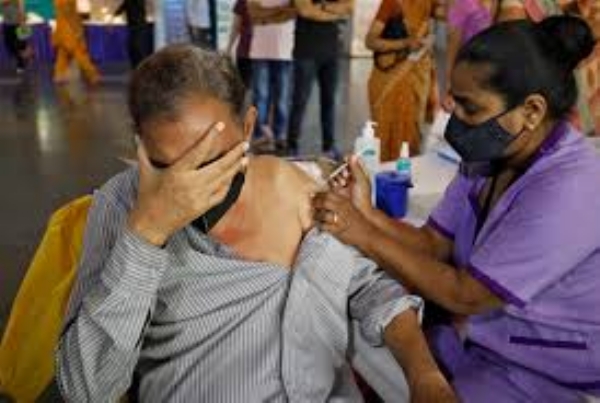
With the Central Government’s push to increase the production of vaccines in India, between June and October, Covaxin will start getting made by three public sector units (Haffkine based in Mumbai, Indian Immunologicals based in Hyderabad and BIBCOL based in Bulandshahr, UP), and the manufacturing capacity will go up more than 7.8 times from just 10 million doses per month in Feb 2021 to ~78.2 million doses by August.

Soon, two more vaccines will be made in India. The first is the Sputnik-V developed by Russia’s Gamaleya Institute, and licensed by the Russian Direct Investment Fund (RDIF) to seven Indian companies. Although Dr Reddy’s Laboratories has started importing Sputnik V which has been approved by the DCGI (Drugs Controller General of India), and the first jabs have already started, the first Indian–made Sputnik V is only expected to hit the market by August. Second is India’s first DNA vaccine for Covid19 to be made by Zydus Cadila, which is also expected to hit the market by August. Third will be a vaccine developed by Indian pharma company Biological E, based on technology from two American hospitals, Texas Children’s Hospital Center for Vaccine Development and Baylor College of Medicine, along with California–based Dynavax Technologies. India’s first mRNA vaccine (Pfizer and Moderna make mRNA vaccines) for Covid19 will come from Gennova by October. In October and November, existing vaccine–makers BB and SII will add two more vaccines, a nasal vaccine by BB, and Covovax to be produced by SII in India under license from Novavax of the USA. The dates are assumptions based on dozens of company statements, government statements, and media reports.
The overall capacity of made–in–India Covid19 vaccines will go up 4.55 times from 60 million doses per month in Feb 2021 to ~273.2 million doses by September.
The AMB has levelled allegations on Modi that he exported (or allowed the exports of) vaccines instead of using them to vaccinate Indians at home
Yes, it is correct that India exported 66.37 million (6.637 crore) doses of Covid vaccines to 93 countries between 20 Jan and 16 April 2021. Out of these, ~35.467 million doses of Covishield and 325,000 doses of Covaxin were sold commercially, while 10.72 million doses of Covishield and 19.86 million doses of Covaxin were given free of cost as grants.
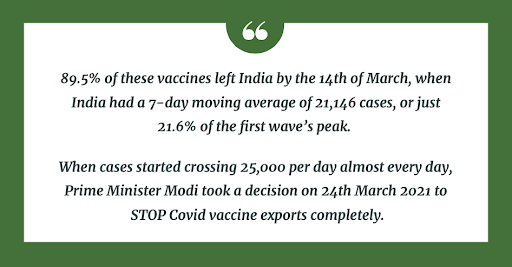
India’s neighbours got 31.9% of the doses. Poor African nations and UN health workers/peacekeepers got 44.3%. Middle-eastern countries which supply us oil and/or have a huge Indian diaspora, got 8%. Overall, ~84% of the total exports of vaccines were as per the commercial and licensing compulsions of SII & BB. The All India Peoples Science Network, a national federation of science networks, issued a statement, urging the Central Government to continue exporting Covid19 vaccines. Like I keep saying, no PM or government can satisfy everyone.
Top American scientist Dr Peter Hotez, Dean of the National School of Tropical Medicine at Baylor College of Medicine in said that the Pfizer and Moderna vaccines may not impact the world’s low and middle income countries, but India’s vaccines have “rescued the world” and India’s contributions must not be underestimated. It is “India’s gift” to the world, Dr Hotez said.
Canadian businessman and investor Patrick Brauckmann said on 23 April, “Important for Canadians and the world not to forget that almost half the vaccines Canada has administered were given to Canada by India because Canada couldn’t source enough.” Hundreds (maybe thousands) of people from many other countries have shared similar sentiments.
On 28th Jan, when Modi told the World Economic Forum’s (WEF) virtual Davos Summit that India would assist other countries with vaccines, the 7–day moving average of new cases was only 13,505, and had fallen from 13,959 a week earlier (~0.98 per lakh Indians) and from 16,347 two weeks earlier. Look at this Table to see how the numbers shot up drastically. Is Modi some kind of superhuman to guess that this would happen, and that too so soon? A 4.13 times increase in just 59 days 25.6 times increase in 90 days???
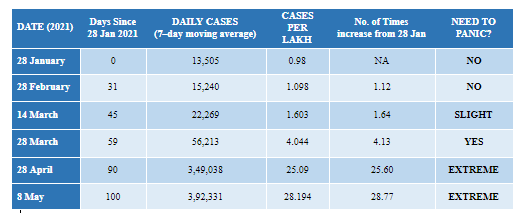
I have factored in the populations on those days, and not taken today’s population. As the situation was fine even on 28th Feb, why should India have stopped exports? By 14th March, 89.5% had already left the country; and the decision to stop exports completely—including unfulfilled commitments of SII towards AZ—was taken within 10 days.
We can blame the elections and the Kumbh Mela, but did these events cause 83.4 lakh infections (83.5% of India’s total) between 26th Feb and 5th May outside of Assam, Kerala, Puducherry, Tamil Nadu, Uttarakhand, and West Bengal, at an average of 1,22,647 cases per day? Or did these events cause 97.25 lakh infections @ 3,24,160 cases per day outside West Bengal, from 13 April (a week after all but the Bengal elections were over) to 13 May? Let us be realistic. I shall give some comparison graphs for the 20 largest Indian states in a later chapter.
Compared to the 6.637 crore doses that were exported, India has administered ~17.93 crore doses to residents in 118 days as on 13th May. Of this, 11.418 crore jabs were given in the last 43 days @ 26.55 lakh doses per day. This was ~14.3% of all vaccine jabs worldwide in these 43 days, and 98.15% of the USA’s jabs. In fact, from 1–17 April, India gave >5.75 crore jabs @ 33.826 lakh jabs a day. The average fell from 18th April onwards as the all mighty USA refused to supply raw materials to SII, which I shall cover later.
See this graph of the number of people who have received at least one dose in 11 countries with >60 million population. Pakistan, Nigeria, Bangladesh, Japan, Ethiopia, the Philippines, Egypt, Vietnam, the DRC, Iran, Thailand, and Tanzania do not even figure in the graph, as their numbers are too low. See India’s numbers compared with much richer nations.

Yes, Israel has vaccinated 62.64% of its population as of 9th May and this fact has been much talked about in the media and on WhatsApp chats, saying India should follow Israel’s example. In the same way, comparisons with Chile, Bahrain, Serbia, Aruba, Hungary, Qatar, and Uruguay—which the Times of India made on 5th May—do not make sense.
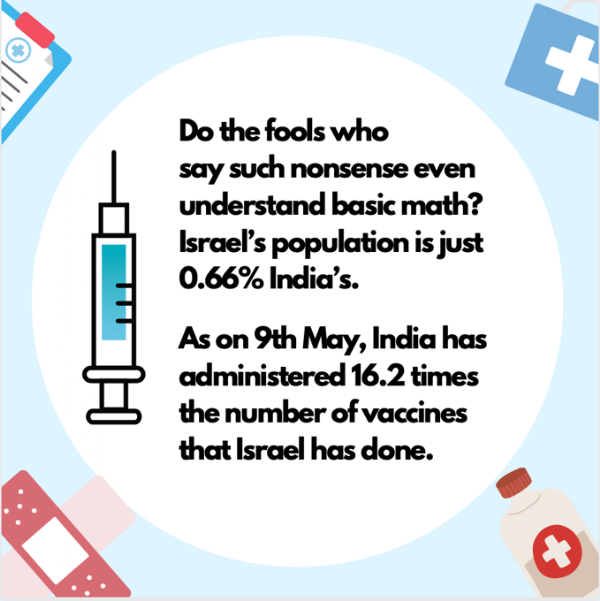
When comparing what percentage of the Indian population has been vaccinated, we should compare ourselves only to large countries (population of over 100 million or 10 crore), which is what the next graph does. Again, countries with very low numbers have been left out. The USA has been left out because its high number makes the lines of countries below India almost disappear
It is clear that India has not done badly at all, considering that Brazil’s Per Capita GDP (PCGDP) is 5.75x of India, Mexico’s is ~4.2x, and Russia’s is 5.3x. In fact, we have done better than Indonesia (~1.94x), the Philippines (~1.66x), and even Japan, which has ~19.6x of India’s PCGDP.
On 10th May, 27 European Union (EU) nations with 5.62 times India’s total GDP and average 17.9 times India’s PCGDP were able to manage only 93.49% of the vaccination numbers India had achieved.
My German friend told me she has not even got a single dose, as only those aged 60+ and special categories such as healthcare workers were eligible. A friend in Canada said is wife and he were waiting for their first shot for over three months, and were told it would be delayed indefinitely as India stopped vaccine exports to Canada.
Did you know that, out of 837 million doses of vaccines which were projected to be manufactured worldwide in 2020, only 3.7% were actually produced? (Source: Airfinity). Therefore, India is not the only country that has had to delay vaccination.
Look at this chart of the world’s largest vaccine manufacturers and the number of doses they are expected to produce in one year from May 2021 to April 2022.
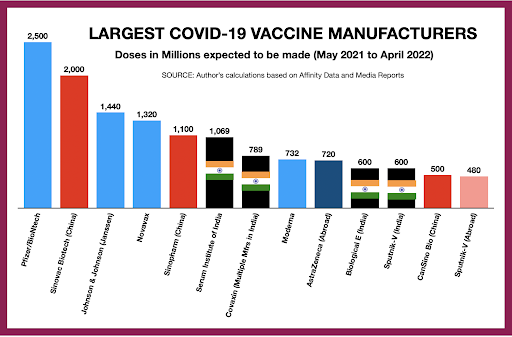
There were controversies raised by the Congress, AAP, TMC, and other members of the AMB, about prices of Covishield and Covaxin being higher for states than for the Centre. SII is selling Covishield to the Centre at ₹150, states at ₹300, and to private hospitals at ₹600. The price for the Centre had been decided back in Oct 2020, and SII makes a loss on each dose at that price.
Here are my assumptions of the financials for the first 184.6 crore doses of Covishield. The profit before tax comes to average ₹18.55 per dose after all 184.6 crore doses are manufactured.
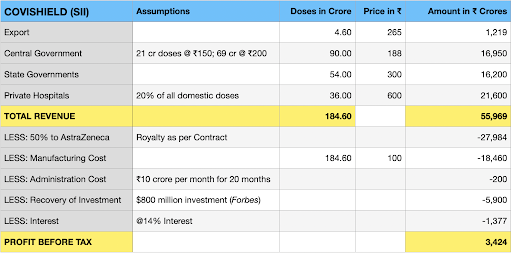
I have done more than enough financial studies in my 20 years as a consultant to say that I cannot be far from the actual numbers. But some genius in the Congress party has calculated that SII wil make a profit of ₹35,350 crores, by assuming that private hospitals will buy 50% of the doses. I think my assumption of 20% is far more accurate. As per the Congress, SII’s profits from Covishield will be ₹350 per dose. To achieve this, SII will have to sell Covishield at an average price of ₹900 per dose (₹450 pay-out to AZ; ₹100 manufacturing cost) and not recover any investments or costs. As the highest price slab is ₹600 for private hospitals, how will they get average ₹900? Can the genius in Congress explain? If Rahul did the calculations himself, then we understand, don’t we.
Here are the calculations for Bharat Biotech. Yes, BB will make big profits as it doesn’t have to pay royalties to a foreign licensor, unlike SII.
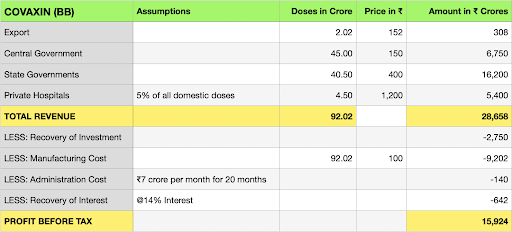
But the Congress genius has assumed their profits at ₹75,750 crores, with a whole lot of wrong assumptions, especially that private hospitals will buy 50.5 crore doses at ₹1200.
All the calculations of the Congress party are based on only the <45 population, as the Central Govt. is taking care of the >45 population. As per Congress, 25.25 crore Indians below the age of 45 will pay ₹1600–2500 for two doses for Covishield and another 25.25 crore people will pay ₹2900–3400 for two doses of Covaxin. Really, Mr. Congress?
Besides, though the Centre is paying ₹150 per dose, it is giving it 100% FREE to the states—after all, it is the states which carry out the vaccinations, not the Centre
As far as the price for private hospitals is concerned, those who are getting vaccinated at private hospitals were surely watching movies at multiplexes before the onset of the pandemic. Consider that the price of Russian and Chinese vaccines is more than ₹750, and that of American vaccines is more than ₹1100–1480, SII’s price of ₹300 and ₹600 is not bad at all, and Bharat Biotech’s price of ₹400 is also fine. But Bharat definitely needs to reduce the ₹1200 price being charged to private hospitals. Does Dr. Ella want to become Mukesh Ambani overnight?
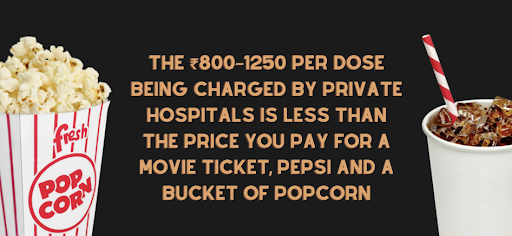
Consider that the price of Russian and Chinese vaccines is more than ₹900, and that of American vaccines is more than ₹1100–1500, SII’s price of ₹300 and ₹600 is not bad at all, and BB’s price of ₹400 is also fine. But Bharat definitely needs to reduce the ₹1200 price being charged to private hospitals. Does Dr Ella want to become Mukesh Ambani overnight?
The Congress and other opposition parties also raised hue and cry to allow import of Pfizer vaccines. All the noise was only for Pfizer, there were no asks for Janssen (Johnson & Johnson), Novavax, or Moderna. Why? Is there any financial interest involved? I wouldn’t be surprised if there is, after all the Congress has been known for dozens and dozens of kickbacks and scams.
In early Dec 2020, Pfizer was the first foreign company to seek emergency–use approval in India but it did not attend subsequent meetings called by our Central Drugs Standard Control Organisation. Pfizer sought to import and distribute its vaccine without doing local trials in India. “Based on … our understanding of additional information that the regulator may need, the company has decided to withdraw its application at this time,” Pfizer said in a statement to Reuters on 5 Feb 2021, adding that it will in the future look to resubmit its application with the additional information that the Indian regulator requires. Pfizer had also wanted the Indian government to sign indemnity bonds that protect the company from being sued in case their vaccine ends up causing any side-effects. There are also unconfirmed reports that the GOI wanted the vaccines at ₹600 per dose, but Pfizer wanted more than three times that price.
There are many other important things to understand about Pfizer’s vaccine. Federal (Central) government officials in the USA had to return several thousand doses after they became ‘too cold’ during the transportation process. Also, as dry ice transport by air poses a cabin pressure risk, it is restricted by the US Federal Aviation Administration to 15,000 lbs (~6,804 kgs), or maximum 10 lakh doses per flight. This was increased from a pre–Covid19 limit of 3,000 lbs. Not all states or cities follow the federal guidelines, and most air transport within the USA is still only 3–4 lakh doses per flight. This is also the average quantity Japan and Israel get per flight.
Considering that India needed total ~194.87 crore doses for the population aged 2+ (the calculations are given later), even if the Pfizer vaccine met only 30% of our needs (~58.5 crore doses), it would mean 1,671 flights @ 3–4 lakh doses per flight. This would cost ₹7052 crores @ ₹4.22 crores for a chartered 38–hour round–trip flight including loading and unloading time between the USA and India (as the aircrafts would have to return empty). Add another ₹192 crores @ ₹11.50 lakhs for a 4–hour round–trip chartered domestic flight (average to cover all airports across India from Delhi, Mumbai, Bengaluru, and Kolkata). Is Mr. Rahul Gandhi planning to donate ₹7244 crores for this noble cause from the very rich Rajiv Gandhi Foundation, which has received donations/grants from the inventors of the Wuhan virus (Coronavirus)?
Next, consider the fact that Pfizer vaccines need ultra–low temperature (ULT) of -60ºC to -80ºC, much colder than a normal freezer (-20ºC) or fridge. Covishield and Covaxin need 2º to 8ºC, and an ordinary fridge is sufficient. Pfizer requires specialised ULT containers (₹14–18 lakhs each) and trucks for transport from the airports to hospitals in 8,000+ Indian towns. Each hospital will need ULT freezers (₹3–20 lakhs each), depending on the number of vaccines they need to store. Add everything, and the cost of vaccinating 30% of India with the Pfizer vaccine would be staggering.
All these hurdles make it very difficult and costly to scale up distribution of the Pfizer vaccine. That’s why Pfizer has been focused on North America. More than ₹175 per dose is just the cost of storage and transport for the Pfizer vaccine.
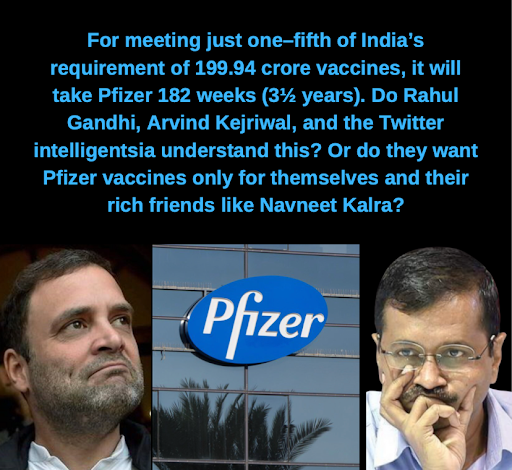
Most importantly, given its production volumes and existing supply commitments, Pfizer can supply maximum ~33 lakh doses per week to India (as per unconfirmed reports). Assuming this triples to 100 lakh doses per week in 26 weeks, meeting 30% of India’s demand will take Pfizer 76 weeks or 17½ months.
Even if Pfizer sold its vaccine to India at a generous price of $25 (₹1850) per dose, we are talking about a cost of ₹2025 per dose for the hospital.
Pfizer vaccines cost ₹3480 per dose in Israel. The price of $19.50 (₹1443) per dose in the USA was only for the first 100 million doses. The company renegotiates prices for every order and has stalled deliveries until new orders are paid. See in the Statista graphic here how the profits of Pfizer and AstraZeneca have gone up by 45% and 167% respectively, in just three months.
A crorepati said on WhatsApp that India should have approved Pfizer and let business houses set up the ULT infrastructure, as “India had five crore people ready to pay ₹10,000 for two doses.”
As per Credit Suisse, India only has ~7.6 lakh dollar millionaires (net worth of $1 million or ₹7.5 crores). India's most authoritative rich list provider Hurun India says that there are 4.12 lakh dollar-millionaire households. Even if we assume that people with a net worth of ₹1 crore can afford ₹30,000 for a family of three, the population won’t cross one crore.
Arvind Kejriwal wrote to Modi that the formulae of Covaxin and Covishield should be shared with other capable pharma companies to scale up production in the country. So that the Chinese also get a hold of it?
I am surprised the IIT–graduate Mr. Kejriwal does not understand that the formula of Covishield is owned by AZ, and not SII or Modi. Besides, the only formula developed locally in India—that of Covaxin—is already being shared with the three PSUs that I named in the second paragraph, and BB has already agreed to share it with any company that can produce the vaccine.
Anyways, the most important thing is to understand by when the entire 18+ population in India will get fully vaccinated with two doses, and this Table explains the requirements.
The 27.27% for those who will refuse to get vaccinated is a conservative number, and the real percentage is likely to be higher, thus further reducing the need for vaccines. Don’t forget that about 35% of Indians live in backward areas, and are against science or technology.
Accounting for 6% wastage, India will need ~144 crore doses for the 18+ population, ~43.3 crore for the population aged 6–17, and ~7.57 crore for the population aged 2–5, or a total of ~194.87 crore doses.
The current wastage is 6.5% nationally. Tamil Nadu had the highest wastage of 12%, followed by Haryana at 9.74%, Punjab at 8.12%, Manipur at 8%, and Telangana at 7.55%. The PM has spoken to most state chief ministers asking them to take measures to reduce or completely do away with this wastage.
About 17.93 doses have already been administered and ~0.95 crore are available with states as on 13th May. This brings down the requirement to 176 crore more doses. So when will everyone who wants to be vaccinated and to whom vaccines can reach, get vaccinated? The figures for Covishield and Covaxin for May 2021 in the chart are for 18 days, since I have already factored in the doses administered and available as on 13th May.
After customs duty and health cess was removed on vaccines by the Central Govt. on 24th April, many states have floated global tenders for the import of vaccines.

Yes, all adults (18+) in India may have to wait until 25 Oct 2021 ( about five months) to get fully vaccinated as per these simple calculations.
But this data disproves the claim of many people in opposition parties, and other members of the AMB, that it will take 44 or 63 months for all 18+ Indians to get two jabs. One lady (I think she was a Trinamool or Left supporter) said on TV that it will take 11 years. Maybe she gets her data from the ISI or the Pakistan Army!
Even if the domestic production and imports don’t increase further, all children and adolescents aged 2–17 can also be vaccinated by 26th November this year.
We can thus hope that there will be lesser critical cases and lesser deaths due to Covid19 in India in the year 2022 and beyond, till the pandemic lasts, if its lasts beyond Mar–Apr 2022 at all.
The AMB keeps asking why the GOI did not (1) get Indian companies to ramp up production earlier; and (2) why did the GOI not import large quantities of vaccines. While both questions may look very relevant without knowing all the facts, let us do exactly that.
Firstly, SII and BB combined had personally promised to the PM that they will produce 20 crore doses per month, but at 8.5 crore, they have as much as 57.5% short of this target. India is not the only country that has had to delay vaccination. Did you know that, as per Affinity, out of 83.7 crore doses of vaccines which were projected to be manufactured worldwide in 2020, only 3.7% were actually produced? India has actually done much better. Besides, contrary to popular belief, India is NOT the world’s largest Covid vaccine manufacturer. India is the world’s largest producer of all types of vaccines, not specifically for Covid vaccines, in which category it is the fourth largest.
On 17th March itself, the Ministry of Health and Family Welfare (MoHFW) set up a 6–member intergovernmental panel to explore how to ramp up vaccine production. Obviously, their decisions would take at least 5–6 months to fructify as it takes minimum that time to set up a Covid19 vaccine manufacturing facility, and the results are evident from the above chart.
Secondly, when Modi announced the vaccination program in Dec 2020, many leading opposition politicians asked their voters and followers not to take the vaccines, as either they were not safe, or their efficacy had not been tested properly. “I will not get vaccinated. It’s the BJP’s vaccine. The BJP can’t be trusted,” said Samajwadi chief and former UP chief minister Akhilesh Yadav.
Throughout January, several Congress leaders came out strongly against the homemade Covaxin. Anand Sharma, a former Union Minister, said the issue of granting authorisation to Covaxin needs to be taken carefully as no country has dispensed with the mandatory Phase–3 trials and verification of data. “The Health Ministry needs to give cogent reasons for dispensing with mandatory protocols and requirements, since it involves the health and safety of those frontline workers who will be vaccinated under the restricted category,” he was quoted as saying by PTI. Other former ministers belonging to the Congress party, including Shashi Tharoor, Jairam Ramesh and Manish Tewari, also spoke up against the use of Covaxin.
In late February and early March, Congress–ruled Punjab and Chhattisgarh, and Left–ruled Kerala refused to use Covaxin. Rahul Gandhi had not taken even the first dose of vaccine till 11th April and was tested Covid19 positive on 20th April.
The media was not far behind. AMB news websites Scroll and Quartz India wrote in Dec 2020 that “distrust in Modi could add to vaccine hesitancy …” The Quint wrote on 4th Jan “Those critiquing the Narendra Modi government on the inadequate information provided on COVID vaccine approval were met with the tag of ‘anti-national’ on social media.” Today, it questions the same government about shortage of vaccines.
This opposition from the AMB is one of the main reasons I have calculated in the yellow Table given earlier that 27.27% of Indians will refuse to take vaccines.
And the opposition was despite the fact that leading doctors had in early January itself spoken in favour of BOTH the Indian–made vaccines. Amongst them, the AIIMS Delhi director Dr Randeep Guleria said that we should trust the expert committees that have recommended the vaccines and move forward, as it is the only way to defeat the pandemic. “We do not have any antiviral drug against the coronavirus, vaccine is our only hope. We should be proactive in rolling out the vaccine as soon as possible and should not get into controversies.” Dr Naresh Trehan, chairman of the Medanta group of hospitals, said that both the vaccines’ efficacy and safety had been established through trials.
With all this opposition, how could the relatively small (when compared to the much larger SII) Bharat Biotech have taken the risk of increasing its production capacity for Covaxin? SII started increasing its capacity from January and was therefore able to start producing six crore doses per month from April. BB took the decision to expand its capacity only after the President and Vice President of India, the PM, and several Central ministers took Covaxin jabs in the first week of March. That’s the reason BB is two months behind in the scaled–up production.
Now let us address the question of why the Modi government did not import vaccines. Which ones would the import? I have already given a detailed explanation for Pfizer.
Johnson & Johnson (Janssen) only applied to the DCGI for approval on 20th April, after it was already too late, but this vaccine is expected to be approved soon. Their single–dose vaccine, however, has run into trouble with the USA calling for a pause in its use after six women developed a rare and severe form of blood clotting after receiving the jab.
India’s Council of Scientific & Industrial Research (CSIR) has been in talks with the Moderna for around seven months to bring its vaccine to India, but the American company is not interested. SII is supposed to manufacture Novavax in India under the brand name of Covovax, but the original schedule of starting manufacturing in June has been delayed to September or October, as the company is busy increasing its Covishield capacity.
The Russian Sputnik Covid19 vaccine got approval in India on 12th April within a month of filing its application to the DGCI. That leaves Chinese vaccines—do you want them?
The USA, under its “Operation Warp Speed” (for Trump-haters and Joe Biden–Kamala Harris fans, fact is that this operation was started by President Donald Trump in May 2020), invested $12.4 billion (₹91,740 crores) in ‘potential’ Covid vaccines to be made by six companies, as per a 14 Dec 2020 article in Time magazine. The operation aimed to provide at least 300 million (30 crore) doses of vaccines by Jan 2021, and 900 million (90 crore) in total.
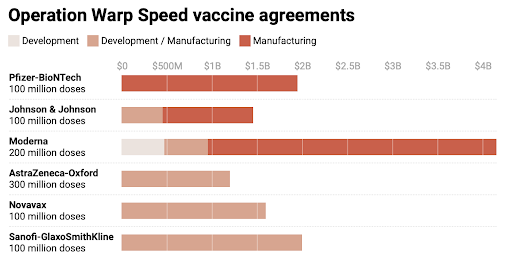
Considering that India needed ~194.87 crore vaccines for the entire 2+ population which wants to get vaccinated, including wastage and the vaccines already administered, and assuming an average price of ₹1400 as a major proportion would need to be imported, could the GOI have invested ₹2.73 lakh crores for a similar operation, and that too within 2–3 months (by 10th March) if the GOI had to save people from the second wave?
The amount that the USA invested was only 0.055% of their GDP and the amount that India would need to invest would be ~2.04% of our GDP, or about 37.1 times that of the USA.
Maybe we should have, but a wiser decision was perhaps taken to be aatmanirbhar. After all, no one was expecting such a severe second wave and the numbers to rise so soon once it started.
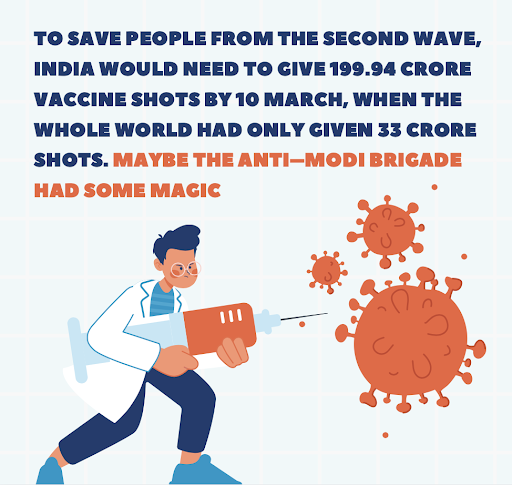
The USA initially refused to send its unused AZ vaccines (same as Covishield made in India), or raw materials required for Indian companies to make vaccines.
“United States first and foremost is engaged in an ambitious and effective and, so far, successful effort to vaccinate the American people. It is not only in our interest to see Americans get vaccinated, but it is in the interest of the rest of the world to see Americans vaccinated,” said a spokesman of the U.S. State Department (their foreign ministry), when asked about raw materials exports to India. Americans think they still own the world, even after China has surpassed them in almost every sphere.
After Foreign Minister Dr S Jaishankar failed to convince his counterpart Secretary of State Antony Blinken, National Security Advisor Ajit Doval (widely considered the third most powerful man in Modi’s government) spoke to his American counterpart Jake Sullivan, and the USA cowed down.
What was discussed will remain an ‘official secret’, but I would not be surprised if it did not have to do with India threatening to blacklist US defence manufacturers from the Modi government’s over $210 billion (₹15.75 lakh crore) weapons procurement program, which includes the immediate (after the economy revives) order of 150 multirole combat jets (114 for the IAF and 36 for the Indian Navy) for an estimated price of $22.5 billion (₹1.69 lakh crore), for which two American companies—Boeing and Lockheed Martin—are trying very hard, especially after losing the earlier 36 aircraft deal to the French-made Rafale. The American ‘Military Industrial Complex’ (MIC) is the most powerful body in that country, as I have elaborated in my book “USAma”. No politician in the USA dare goes against the wishes of the MIC. If it was not this reason, why would our NSA have to speak to their NSA? In ideal circumstances, our defence minister should have spoken to his counterpart, but using a translator could have been catastrophic, and I doubt that General Lloyd Austin could have understood the accent of Rajnath Singh, or vice-versa.
Once they had cowed down, not only did the USA agree to send us 20 million doses of the AZ vaccine (1% of India’s requirement), but also agreed to send raw materials for our vaccine manufacturers, and a host of other drugs and medical supplies.
Last, let’s look at which states have vaccinated well, and which haven’t (as on 11 May).
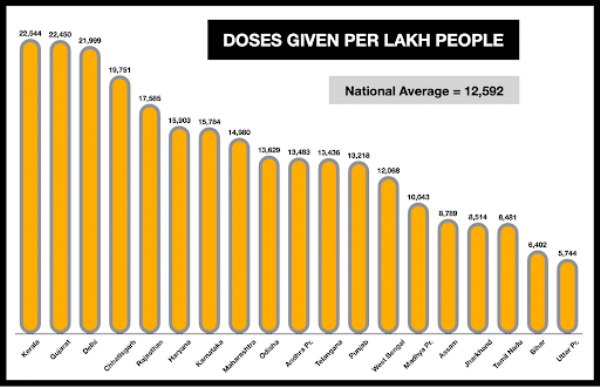
I believe you can decipher the above data by yourself.
Here are the conclusions about India’s vaccination needs and supply, about why vaccination has been delayed, when we will all get vaccinated, and some global comparisons.
